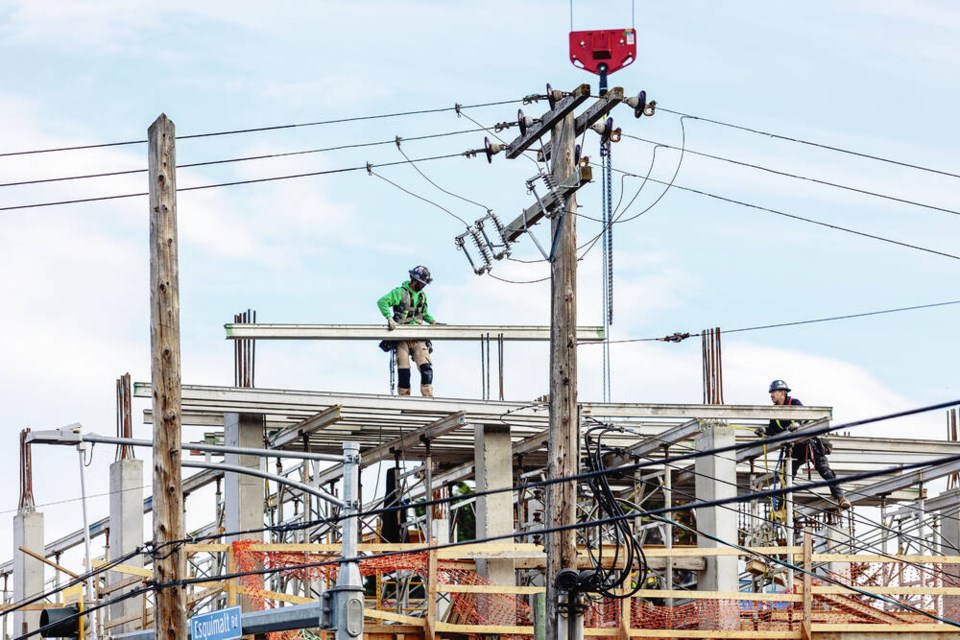After the NDP government set the stage for the biggest residential construction boom since the end of the Second World War, what is the B.C. Finance Ministry’s estimate of the impact?
They’re predicting housing starts will drop by 4,500 next year.
Honestly, what does it take to impress these people?
Either the government’s economic analysts are pessimistic to the point of hopelessness, or the NDP is vastly overselling the effect of the zoning and building bonanza it is trying to legislate into existence.
A quarterly update on the government’s finances was released Tuesday and it’s the second one in a row that predicts the government’s big housing push on all fronts won’t amount to nearly as much as the politicians expect.
The update said home building has been robust so far this year and hit almost 50,000 year-to-date in September. That’s well above B.C.’s 10-year average.
But residential building permits started slowing recently, “signaling potential moderation going forward.”
The value and the numbers of permits have dropped 20 and 13 per cent respectively.
“The ministry prudently expects housing starts to total about 47,400 units in (calendar) 2023 and 42,900 units in 2024 …”
So after outlawing single-family-home zoning in most of urban B.C., giving blanket approvals for up to six units on most lots, prezoning transit corridors for big condo towers and paving the way for instant approvals of nearly everything, the analysts expect 4,500 fewer housing starts next year.
It’s almost exactly the same outlook as the one posted three months ago, although the numbers have been adjusted slightly upwards.
Finance Minister Katrine Conroy responded by distancing herself from her own staff, saying she is “a bit more optimistic.”
She also said the discrepancy between the NDP’s political expectations and the analysts’ data-based outlook stems from how housing starts are counted by Canada Mortgage and Housing.
They don’t include student housing, for one thing. The increased availability due to the expanded speculation and vacancy tax and the new short-term rental curbs aren’t counted either. They are supposed to tackle the crisis, but don’t count as starts.
The ministry’s rationale for low-balling the housing forecast includes rising interest rates, reduced profitability due to tighter financing conditions, labour shortages and rising construction costs.
So the most current point on the CMHC’s graph of housing starts in B.C. shows the number is just a tick above the historical 10-year average of 39,000 starts a year.
That 10-year average is what contributed to the crisis in the first place, since it obviously hasn’t been enough to affect affordability.
Everything in the NDP rhetoric around the housing legislation of the past two months has promised much better performance than that, starting with the grand estimate that 130,000 new small-scale multi-unit homes will be built in the next decade, thanks to all the changes.
With B.C.’s population growing three per cent a year, maintaining any number near the 10-year average amounts to just maintaining the status quo.
The ministry, which is historically conservative when it comes to forecasting, may simply be under-estimating. Or an NDP government that is 11 months at most away from an election is deliriously optimistic about what the housing push is going to accomplish.
That estimate of 130,000 new homes in a decade thanks to the housing legislation, by the way, was queried in the legislature a few days ago.
Green MLA Adam Olsen asked to see the modelling on which it was based. Housing Minister Ravi Kahlon said it will be released soon.
But that meant a few weeks, and the legislature will adjourn Thursday. Olsen said it was ridiculous and absurd to pass the legislation when the NDP won’t release key background documents about what it hopes to achieve.
Same goes for the claims prices will drop seven to 14 per cent in the next few years thanks to the increased supply.
Is that analysis public?
Nope.
Not until the regulations to come have gone to cabinet, said Kahlon. That will be well after the debate is over.
As it stands, there’s more information currently available to support the Finance Ministry’s pessimistic outlook than there is to back the NDP cabinet’s optimism.



